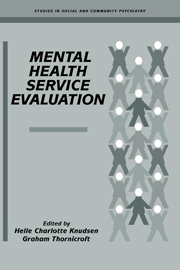Book contents
- Frontmatter
- Contents
- List of contributors
- Foreword
- Preface
- Part I INTRODUCTION
- Part II COMPREHENSIVE SERVICE EVALUATION PROJECTS
- Part III METHODS: MEASUREMENT, STRATEGIES AND NEW APPROACHES
- Part IV SYSTEM-LEVEL RESEARCH
- Part V PROGRAMME-LEVEL RESEARCH
- 16 Randomised controlled trials of programmes
- 17 Individual patient outcomes
- 18 Caregiving in severe mental illness: conceptualisation and measurement
- 19 Needs assessment
- Part VI HEALTH ECONOMICS IN MENTAL HEALTH
- Index
19 - Needs assessment
from Part V - PROGRAMME-LEVEL RESEARCH
Published online by Cambridge University Press: 05 August 2016
- Frontmatter
- Contents
- List of contributors
- Foreword
- Preface
- Part I INTRODUCTION
- Part II COMPREHENSIVE SERVICE EVALUATION PROJECTS
- Part III METHODS: MEASUREMENT, STRATEGIES AND NEW APPROACHES
- Part IV SYSTEM-LEVEL RESEARCH
- Part V PROGRAMME-LEVEL RESEARCH
- 16 Randomised controlled trials of programmes
- 17 Individual patient outcomes
- 18 Caregiving in severe mental illness: conceptualisation and measurement
- 19 Needs assessment
- Part VI HEALTH ECONOMICS IN MENTAL HEALTH
- Index
Summary
Introduction
In recent years a consensus has emerged between clinicians and planners in many countries that mental health services should be provided in relation to needs, but often are not. If such services aim to meet needs, at the levels both of the individual patient and of the whole population, then three key issues emerge: how can needs be defined, who should assess them and how can this information be best used? This chapter addresses these issues in three stages: by presenting definitions of need, by reviewing methods of assessing individual needs for treatment, and by discussing how needs for services at the population level can be measured.
Defining needs
There is at present no consensus on how needs should be defined (Holloway, 1994), and who should define them (Ellis, 1993; Slade, 1994). The Oxford English Dictionary offers ‘necessity, requirement and essential’ and in a different sense ‘destitution, distress, indigence, poverty or want’. These clusters of meanings overlap in so far as they define ‘need’ as a vital element which is lacking, and this chapter will use this sense as its point of departure. ‘Need’ will therefore be used here to refer to significant essentials of life which are insufficient. The fact that a need is defined does not mean that it can be met. For example, some needs may remain unmet because other problems take priority, because an effective method is not available locally, or because the person in need refuses treatment.
In psychological terms, Maslow (1968) has set out a hierarchy of four levels reflecting, in sequence, needs for physiological functioning, safety, love and self-actualisation. Similarly, from a philosophical analysis of the field, Liss (1990) has distinguished four elements of need. First is the ‘ill health’ approach which equates need with a deficiency in health that requires medical care. In this model the required intervention is simply the provision of the absent treatment. For Mailman & Marcus (1980), for example, need is ‘an objective requirement to avoid a state of illness’ (p. 165). Second, Liss describes the ‘supply notion’, where the existence of a need presumes that an acceptable and effective treatment exists to offer remedy, and this is referred to by Stevens & Gabbay (1992) as ‘the ability to benefit in some way from health care’.
- Type
- Chapter
- Information
- Mental Health Service Evaluation , pp. 317 - 338Publisher: Cambridge University PressPrint publication year: 1996
- 4
- Cited by



